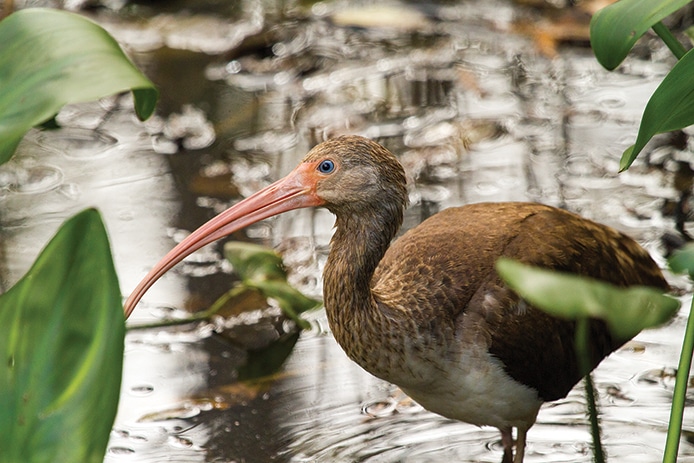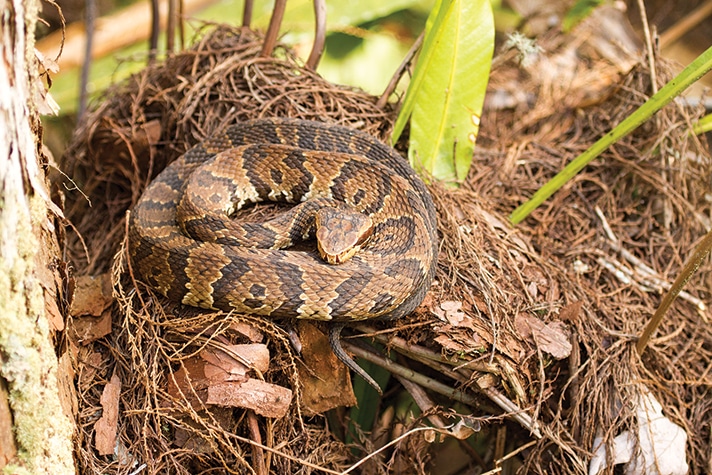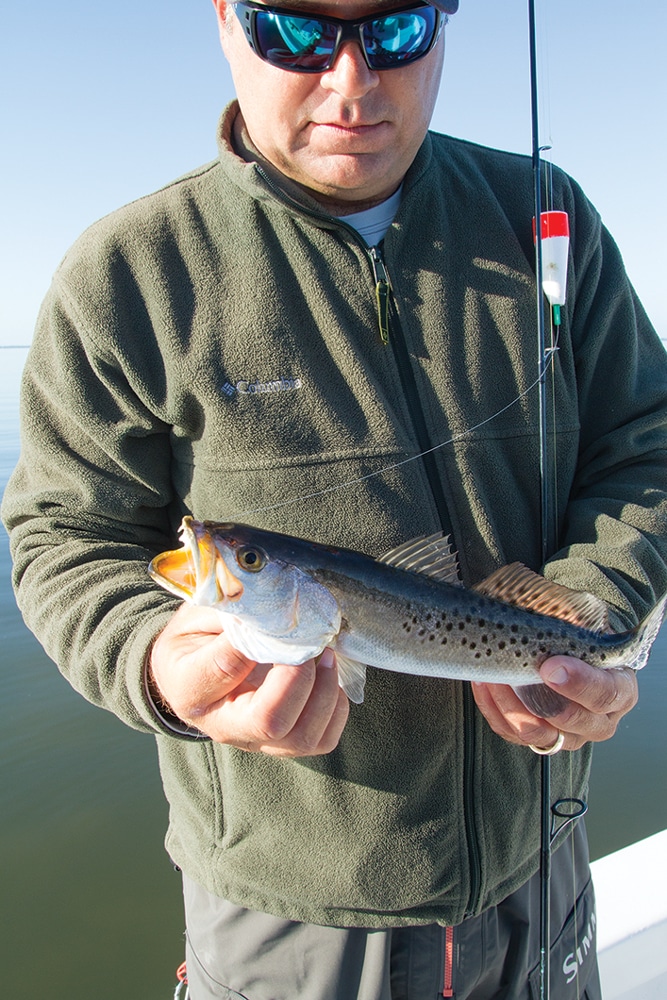An RV-friendly destination in southwest Florida with untouched beaches, unparalleled wildlife viewing and fascinating history
It’s no secret that Florida is a favorite motorhome destination, especially for snowbirds escaping wintery weather. But much of Florida has been over-developed, leaving this tropical paradise smothered in high-rises and strip malls. One place where much of natural Florida is still intact is Fort Myers, an RV-friendly destination in southwest Florida that boasts unspoiled mangrove forests, saltwater wetlands, wildlife refuges, tropical gardens, nature trails, miles of winding canals and waterways and some fascinating history – and we’ve come to take a look.

A juvenile white ibis (its feathers haven’t molted to white) in Corkscrew Swamp Sanctuary south of Fort Myers, stalks the water for prey.
Bordered by the Gulf of Mexico to the west and the wide Caloosahatchee River to the north, the area encompasses a little less than 50 square miles (9 square miles under water). The land is flat, with elevation gains of 10 feet or less, and the roads are wide and well-paved, making it a breeze to drive a motorhome. All around are expansive stretches of pines, saw palmettos, woody shrubs, wild grasses and wildflowers; freshwater marshes and mangroves; and coastal areas covered in hardy, salt- and wind-resistant succulents and sea grasses.
While there are dozens of great places to camp in Fort Myers, we choose Red Coconut RV Park, the only beachside RV park in the area, as our home base. Like many RV parks in Florida, Red Coconut offers full-time and transient sites. The park is cut into beachside and non-beachside campsites by Estero Boulevard, the main road traversing narrow, 6-mile-long Estero Island. It’s the 450 feet of pristine beachfront that draws RVers year after year to Red Coconut. The park offers 60 full-hookup sites with Wi-Fi, as well as shower and laundry facilities on the beachside and additional RV sites across the boulevard.
While we didn’t secure a front-row beach site (folks can wait years for those), we’re just a few rows back in a space with a concrete-pad patio and picnic table. Best of all are the Gulf breezes and broad swath of white sand just a few steps away.
Because Estero Island is a main beach access point for the peninsula and has only one road, traffic can back up, especially on weekends. While most of Fort Myers is easy to navigate by motorhome, a dinghy is the best idea on the island. We use ours every morning to zip up to Heavenly Biscuit, a hole-in-the-wall café serving delightful biscuit sandwiches and addictive cinnamon rolls; stock up on groceries at the local supermarket; and shop super-cool, outdoorsy Times Square mall for colorful beach towels and hooded sweatshirts (some days it’s unseasonably cool).
Into the Wild

The sign at Corkscrew Swamp Sanctuary identified this snake as a water moccasin, a poisonous viper that lives in the swamp.
With its shops, white-sand beaches and easy-going lifestyle, it’s tempting to hang out on Estero Island. But we’ve come for the wilder side of Fort Myers. We head south 5 miles on Estero Boulevard and over Bonita Beach Causeway to Lovers Key State Park. Before the causeway was built, Lovers Key gained a reputation as a romantic place for couples that boated to the island to picnic. Today, Lovers Key is part of 1,616 acres of undeveloped barrier islands with native landscape and plenty of flat biking and hiking trails and sheltered waters for fishing, canoeing and kayaking (rentals available). Park rangers give guided tours and teach everything from birding to cast-net throwing.
While I wish we’d brought our bikes, (they’re back at the motorhome), we opt for hiking Black Island Trail, a twisty dirt path that wends through the scrub and occasionally skirts the water, and enjoy the informative signs about local plants and wildlife.

The Intracoastal Waterway offers calm waters and great fishing. It’s a keeper! This brown trout caught in Pine Island Sound just off Fort Myers, Florida, was big enough to enjoy for dinner.
For an even wilder look at this area, we scoot over to Corkscrew Swamp Sanctuary, a 13,000-acre swamp operated by the Audubon Society that contains the largest remaining stand of old-growth bald cypress in North America. When we walk into the sanctuary’s education center, there’s a buzz in the air because endangered wood storks, one of the largest of the magnificent stork family, are nesting here for the first time since 2009. We head out, cameras at-the-ready, on the 2.25-mile boardwalk that meanders through pine flatwoods, wet prairie, around a marsh and finally into the old-growth bald cypress forest. These impressive trees, relatives of the redwood, tower 130 feet, have a girth of 25 feet and their massive branches are heavy with ferns, mosses, lichens and colorful bromeliads. It’s a sight that makes us feel humbled by nature’s beauty and diversity.
Halfway through the boardwalk, we climb onto a raised viewing platform and peer through the scope at the wood stork rookery. We’re disappointed that the big birds and their nests are pretty far away, but this is, after all, a sanctuary. This perfect environment is why this place has supported 100,000 of the big birds since monitoring started in 1958.
On our way back to the education center, there’s a sign that says “water moccasin.” And, sure enough, there’s a thick curled up snake snoozing in the crook of a tree next to the walkway. It sends a shiver up my spine and I’m grateful there’s a thick plexiglass barrier between this venomous water snake and me.
The next morning, we’re up early to meet Captain Ryan Kane with Southern Instinct Fishing Charters for a half-day saltwater fishing trip. Kane, a gregarious guy with a raccoon-eyed sunburn, has been fishing the salt and fresh waters around Fort Myers his entire life. We scramble aboard his small, open-air Proline Flatback, a once-rotting derelict that he and his buddies restored and turned into a boat that can easily cruise the shallow Gulf waters.
Kane fires up the engine and motors through dozens of tiny islands into open water. Southwest Florida waters are renowned for fish, especially snook, redfish, speckled trout and the famous fighter, the tarpon. Our prize today is speckled trout and it doesn’t take long once Kane baits our lines to start reeling in these little beauties. Unfortunately, most are too little and we toss them back. We do bag a couple and, at dinner in our rig, enjoy some of the freshest fish we’ve ever eaten.
The next morning, on our way to Six Mile Cypress Slough Preserve, we stop at Sun Harvest, a popular citrus company that offers free (and unlimited) samples of uber-fresh orange, grapefruit, and other fruits and juices. We get hooked on the orange juice and buy a gallon as well as some oranges and grapefruit.
With lakes and swamps filled with gators and cypress trees dripping with epiphytes like orchids and bromeliads and Spanish moss, Six Mile Slough is an otherworldly Jurassic Park. Despite a low din from nearby traffic, the place is so peaceful we find ourselves whispering. At one time, wetlands like Six Mile were considered a nuisance to progress. Fortunately, scientists now know that marshlands provide flood control, water storage and purification, and naturally recharge aquifers.
We’d planned to spend only an hour or so walking the 1.2-mile boardwalk that traverses this 2,500-acre preserve, but the white ibis, snake-like anhingas, and great blue and little green herons have us snapping photos for hours.
The next day it’s chilly and despite all the preserves and natural areas we have visited, we have yet to encounter manatees, the area’s legendary “sea cows.” I ask a fellow RVer at Red Coconut RV Park and he tells us that when the water temperatures drop below 68 degrees Fahrenheit, the big animals head for warm waters like those found in Lee County Manatee Park.
Located just off Palm Beach Boulevard (FL 80), Manatee Park is a small park next to the Orange River and the outflow canal from an electric power plant. It’s the warm outflow water that attracts the manatees and the dozens of residents and visitors who cram spots overlooking the canal. A dozen or so of the 1,000-pound, grayish mammals, including some babies, float in the water, rising and sinking like gigantic dirigibles. The naturalist tells us that manatees, despite their size, have little body fat, which is why they can’t fend off the cold. Today’s temperature in the Orange River is 64 degrees Fahrenheit; in the canal it’s a toasty 72 degrees Fahrenheit.
Inventions, Historic Homes and Juicy Burgers

Thomas Edison’s lab at Edison & Ford Winter Estates still contains many of his machines and lab equipment.
For a change of pace, we head to historic downtown Fort Myers, a walkable town that’s home to the Edison & Ford Winter Estates. The city is known as the City of Palms for the many palm trees that Thomas Edison (and later others) planted along the streets.
In 1885, inventor Thomas Edison purchased land along the Caloosahatchee River and built a vacation home he called “Seminole Lodge.” The house served as his winter retreat until his death in 1931. His good friend Henry Ford purchased the adjoining property, “The Mangoes,” in 1916. Today, the 17 acres that include the historic homes, gardens, museum and Edison’s laboratories, give visitors a rare look at the slower pace of Old Florida and insights into the lives of two famous men who shaped modern America.
We walk beneath a 400-foot-tall banyan tree (planted in 1927 as a 4-foot sapling) into the Edison Museum where artifacts and photographs tell the story of the great inventor’s many projects. We learn that Edison invented the light bulb, phonograph, and the motion picture camera and hundreds of other innovations. In fact, he held 1,093 patents and filed patents every year for 65 years.

An early film projector at the Edison & Ford Winter Estates Museum is one of Edison’s thousands of inventions.
Edison’s laboratory, located just outside the museum, is where the self-taught scientist searched for a replacement for natural rubber to fill America’s growing demand for tires. The intact workshop is filled with pipettes, test tubes and all manner of heavy machines.
We meet Nadia, a historian and our guide for a 75-minute guided tour. We cross the palm-lined street to Seminole Lodge and peer through the windows of Edison’s clapboard house. When Mrs. Nina Edison, his second wife, donated the home and land, Nadia tells us, she also donated all the furnishings and artifacts, too. Next door, at Ford’s home, we check out the 1917 Ford Model-T truck and 1929 Model-A sedan in the carriage house.
The grounds and gardens are fascinating as well. Our guide points out unusual plants from all over the world, like allspice, banana trees and royal palms from Cuba that Edison planted along the city’s streets.
By the time we end our tour, we’re famished and wander downtown to a local eatery appropriately called Ford’s Garage. Decorated with garage memorabilia, including tire sinks and gas-pump-nozzle faucets, this theme restaurant is buzzing with locals and visitors. As we sit outside at a small umbrella table and tuck into big, juicy burgers, we know Fort Myers is worth visiting more than once.
For More Information

Bald cypress, a deciduous conifer that loses its vibrant green color in the winter, stand in the swamps at Corkscrew Swamp Sanctuary. Raised boardwalks provide a 2.25-mile-loop trail through the sanctuary.
Corkscrew Swamp Sanctuary
239-348-9151 | www.corkscrew.audubon.org
Edison & Ford Winter Estates
239-334-7419 | www.edisonfordwinterestates.org
Lee County Visitor & Convention Bureau
800-237-6444 | www.fortmyers-sanibel.com
Lovers Key State Park
239-463-4588 | www.floridastateparks.org/loverskey
Red Coconut RV Park
239-463-7200 | www.redcoconut.com


